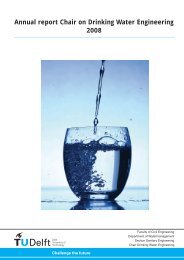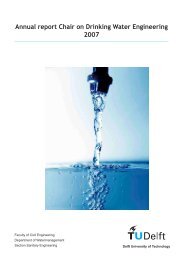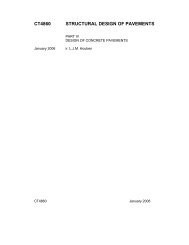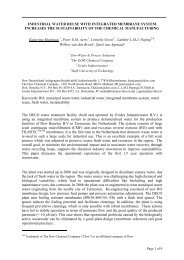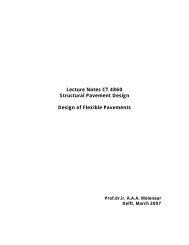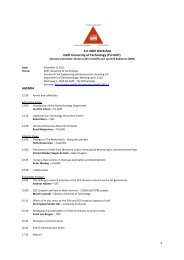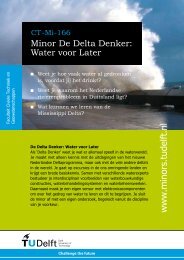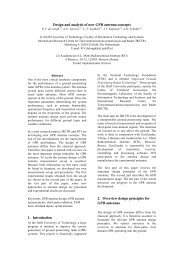CHAPTER 5 CONCRETE PAVEMENTS - TU Delft
CHAPTER 5 CONCRETE PAVEMENTS - TU Delft
CHAPTER 5 CONCRETE PAVEMENTS - TU Delft
Create successful ePaper yourself
Turn your PDF publications into a flip-book with our unique Google optimized e-Paper software.
Next a fatigue damage analysis is carried out for the locations VR and ZR by<br />
calculating the allowable number of load repetitions Ni for each combination of wheel<br />
load Pi and temperature gradient ∆ti. In the damage analysis the following concrete<br />
fatigue relationship (50% fatigue curve, so an average relationship) is used:<br />
12.<br />
903 ( 0.<br />
995 − σ max / fbtg)<br />
i<br />
= with 0.<br />
5 ≤ σ / fbtg ≤<br />
1.<br />
000 − 0.<br />
7525 σ / fbtg<br />
log N i<br />
max<br />
min<br />
where:<br />
i<br />
0.<br />
833<br />
(5.12)<br />
Ni = allowable number of repetitions of wheel load Pi i.e. the traffic load<br />
stress σvi until failure when a temperature gradient stress σti is present<br />
σmin i = minimum occurring flexural tensile stress (= σti)<br />
σmaxi = maximum occurring flexural tensile stress (= σvi + σti)<br />
fbtg = average flexural tensile strength (N/mm 2 ) of unreinforced (plain)<br />
concrete under loading of short duration:<br />
fbtg = 1.4 (1.6 – h/1000) (1.05 + 0.05B) (5.13)<br />
where: h = thickness (mm) of the concrete slab<br />
B = characteristic cube compressive strength (N/mm 2 ) after 28<br />
days (see table 5.1)<br />
The design criterion (i.e. cracking occurs) is the cumulative damage law of Palmgren-<br />
Miner:<br />
n<br />
i<br />
∑ = 1.0 (5.14)<br />
i N i<br />
where:<br />
ni = occurring number of repetitions of wheel load Pi i.e. the traffic load<br />
stress σvi during the pavement life when a temperature gradient stress<br />
σti is present<br />
NI = allowable number of repetitions of wheel load Pi i.e. the traffic load<br />
stress σvi until failure when a temperature gradient stress σti is present<br />
5.4.5 Stiffness criterion:<br />
To prevent longitudinal unevenness (joint faulting) at the transverse joints in the plain<br />
concrete pavement the deflection of the transverse edge in the wheel track (location<br />
VR in figure 5.12) due to the traffic loading should be limited. According to<br />
Westergaard the deflection of the transverse edge is (2,13):<br />
⎛ W ⎞ ⎛ P ⎞<br />
wl = λ ⎜1<br />
− ⎟ ⎜ 2 ⎟<br />
(5.15)<br />
⎝ 200 ⎠ ⎝ kl ⎠<br />
181



